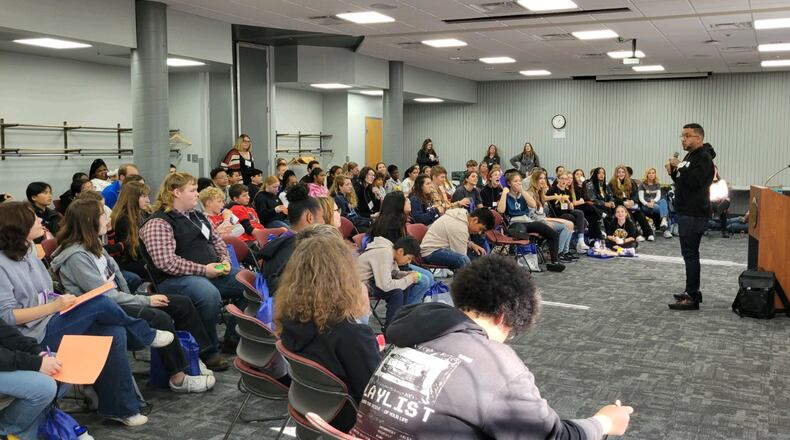Youth summits have grown since their establishment. Beth Dixon, prevention education coordinator with WellSpring, said the theme was based on data that revealed about 27 percent of local students can feel alone with nowhere to turn when feeling depressed or anxious.
“This concerns us. No kids should fall through the cracks,” said Dixon. “This is an opportunity for middle school students to dive into prevention.”
Participating middle schools included Shawnee, Schaefer, Hayward, Roosevelt, Ridgewood and two newcomers – Tecumseh and Greenon. Several high school students and adult volunteers also helped along with Wittenberg’s psychology department. Members of the Bringing Awareness to Students (BATS) student group and students of the School of Innovation taught about peer pressure and effective ways to say no to things someone doesn’t want to do.
During the sessions, students were asked to think about the stressors in their lives and how to deal with them. Having the variety of middle schools allowed the kids to reflect on how similar and different these stressors are.
Honey Bell-Bey, a poet laureate and educator, was the keynote speaker and led the session on resiliency, Stephanie Little of Wittenberg and Kyle Johnson of Springfield City Schools also did sessions, while Javier Sanchez of Youth to Youth International was the closing speaker.
The summit is the starting point for the students to use their new skills and knowledge to do a variety of things in their districts including teaching an elementary classroom about peer pressure and saying no; participating in the National Day of Unplug in March, devoted to turning off electronic devices for more together time; and plan a project that improves resiliency and addresses those students who may not share their feelings of depression or anxiousness.
Kayrie Manaois has only been in Springfield for a year, having lived in the Philippines. She did her first summit a year ago as a seventh-grader at another school and is continuing at Ridgewood.
This experience and joining the BATS program and has been instrumental in helping Manaois assimilate here. She likes the students are diverse and admits to being nervous she’d be judged but is now accepted easily into her group.
“I was scared to talk and now I feel like I can talk. Being here felt inspirational, and the poetry was amazing, and I also got to meet with my old school friends,” Manaois said.
Shawnee Middle School seventh graders Gabbie Meade and Madi Lee were impressed with their first summit, the chance to meet new people and develop skills they can use in school and elsewhere.
“I liked how they related resilience to things in life,” said Meade. “I think we can show younger people how to show resilience. I came home super happy with what I learned.”
Lee’s takeaway was to not give up but keep pushing and how she can apply this to her life.
Shawnee counselor Sherry Akers said empowering, youth-led programs are important in knowing the challenges their peers are going through.
The students will come back together in May at a spring youth summit to share their projects and experiences.
Dixon is excited to see the program transform from adult-led to a more youth-led, with the students designing the content and sessions.
“Adults were making the decisions, but when you turn it over to kids, boy, does it get innovative when you trust kids,” she said.
Dixon also credits the many organizations who contribute to the summit, calling it an amazing example of coalitions working together.
About the Author
